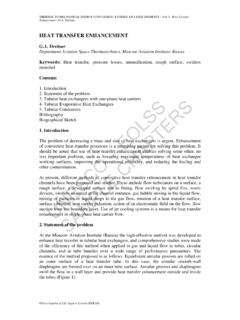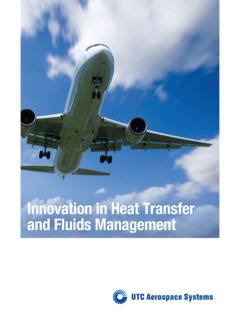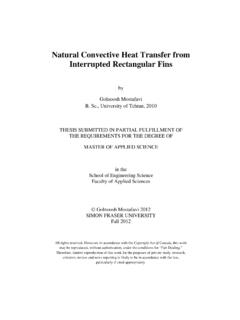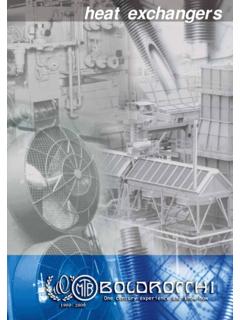Transcription of A REVIEW OF SOLID PROPELLANT BURN RATE …
1 A REVIEW OF SOLID PROPELLANT burn RATE ENHANCEMENTBY mechanical METHODSDAVID inclusion of metal fibers in a SOLID PROPELLANT grain has been shownto increase its bulk burning rate dramatically, and is a technology that was applied inseveral early sounding rockets. This REVIEW covers historical and current applications forthe technology, as well as the theoretical basis for burning rate enhancement . Thoughtechnically successful, the use of wires to achieve high burning rates has largely beenreplaced with the use of reactive catalysts and other high burning rate energetic , recent concern over the sensitivity of such propellants is generating interest inother means of accelerating burn rates . As such, several practical research topics involvingwire enhancement of burning rates are presented to reintroduce this technology into themotor designer s usefulness of SOLID rocket motors in many applications is limited by the burning rateof the PROPELLANT which they contain.
2 Propellants are typically burned in the combustionchamber either radially, with a center perforation, or axially along a SOLID length. Sinceburn duration is proportional to the thickness of PROPELLANT being burned, such geome-try constraints restrict the burn times achievable using typical SOLID rocket propellants toeither relatively short or extremely long durations. A high burning rate PROPELLANT (>1in/sec) opens up a further range of possibilities, allowing motors of moderate burn dura-tion (15-60 sec) to be fabricated in aspect ratios favorable to applications in missiles andsounding rockets. Techniques for creating high burning rate composite propellants includechemical catalysis, inclusion of high burning rate energetics in the composite, modificationof constituent particle size, and mechanical modification of the PROPELLANT grain to increasethermal inclusion of energetic materials and burning rate catalysts from the metallocene fam-ily ( , ferrocene and catocene) was shown early in the history of composite propellanttechnology to be a promising avenue for increasing PROPELLANT burning rate efficiently [1].
3 However, such chemicals also greatly increase PROPELLANT sensitivity, presenting significantprocessing and handling size modification is a current research topic, and the advent of nanomaterialsshows significant promise for generating predictable high burn rates without the inclusion12 DAVIDREESEof sensitive materials. Problems arise, however, from the significant rheology and pro-cessing problems presented by the inclusion of ultra-fine particles, and the current cost ofnanoenergetics remains a barrier to full-scale modifying the thermal diffusivity of the composite with the inclusion of solidmetal filaments was shown to be a useful technique as early as 1955 [2]. Indeed, severalpatents were granted on wired burning rate technology in the early 60s [3][4]. The inclusionof wires in the PROPELLANT shows promise for generating extremely high bulk burning rates (2-5 in/sec) without modification of the composite chemical composition.
4 The downsidesto the technology include processing difficulties, increased radar signature, and usefulnessonly in certain grain geometries [5].Perhaps for these reasons, very little current research into and production of motors usingwires to enhance burning rate exists. This paper will highlight current state of the artapplications for wire-enhanced burning rate technology. In addition, the theoretical basisfor this burning rate mechanism will be examined, and several models presented for areas for future research will also be ApplicationsIn the United States, the concept of increasing PROPELLANT burn rates with embedded metalwires was first explored by Rumbel, et al. at Atlantic Research Corporation in 1955 [2].ARC used this technology in several sounding rockets, beginning in 1958 [6].
5 The mostsuccessful of these vehicles, ARCAS, remained in use until 1991 [7]. These sounding rocketswere designed using PVC plastisol PROPELLANT [8], and the inclusion of axially embeddedwires in the PROPELLANT grain produced a burning rate enhancement of nearly 400%. Thisallowed the vehicles to use an endburning grain geometry, resulting in gentle vehicle accel-eration and burn times between and seconds ideal for fragile electronic payloads[6].Wire enhancement of burning rate also proved popular for missile development. The end-burning configuration pioneered by ARC produced not only longer action times, but alsohigher mass fractions, allowing the developed missiles to be smaller. As such, wire-enhancedmotors were fielded extensively in the Redeye and Stinger missile programs [9]. of OperationThe seminal model of the combustion process of a PROPELLANT with embedded metal wireswas developed by Caveny and Glick in 1967 [5].
6 It was the first model to account for bothtransient and steady-state burning rates of propellants with embedded wires, and thus canbe used to model either chopped wire distributed throughout the PROPELLANT , or strandedwire embedded as a single piece in the 3 Figure imaging of a PROPELLANT strand surrounding a silver wireat ignition (a) and during regression (b). Note the cone-shaped burningsurface. [14]The mechanism by which the local burning rate increases is essentially that of increasedthermal diffusivity in a narrow region around the wire. This region forms the shape of acone (shown in Fig 1), with the half-angle c=sin 1 rm rw ,where rmis the burning rateof the PROPELLANT matrix, and rwis the burning rate of the PROPELLANT along the wire. Thisgeometry is illustrated in Fig Caveny-Glick model examines a 2D slice of burning PROPELLANT with a single rectangularwire embedded in its center.
7 Experimental results show burning occurring in three phases:a start transient, accompanied by an increase in burning rate as the wire is exposed;a steady-state burn ; and a stop transient, accompanied by another increase in model the phases successfully, the combustion process was divided into four zones, asshown in Fig 2. Thepropellant thermal zoneis the zone in which heat conduction occursfrom the burning surface into the PROPELLANT . For the purposes of calculation, this zoneis assumed to be very thin, as typical composite PROPELLANT is a good thermal thermal zonesurrounds the metal fiber embedded in the PROPELLANT , and thus4 DAVIDREESEF igure geometry in the Caveny and Glick combustion model. [5]contains PROPELLANT that has been preheated by the wire. It is assumed that the propellantmaintains contact with the wire; investigations by King [10] have shown that the separationof PROPELLANT from the wire has a large effect on burn rate.
8 Theinteraction zoneis definedas the intersection of the fiber thermal zone and the PROPELLANT thermal zone, and finallythegas phase reaction zoneis where the bulk of the chemical reactions in the propellantoccur. As with most models of PROPELLANT regression, gases are modeled as exiting normalto the burning surface of the grain; the gases are then assumed to gently turn to flowparallel to the embedded ease of calculation, several basic assumptions are made as well. The PROPELLANT isassumed to be homogeneous and isotropic, and the gas flow inside the motor is assumedto be inviscid quasi-steady flow at a low Mach number. Since the temperature gradientacross the embedded wire is large, it is assumed to be thermally thin , as the thermalconductivity of the wire is typically two orders of magnitude higher than the thermalconductivity of the PROPELLANT .
9 Additionally, heat transfer in the interaction zone and outthe end of the wire is assumed to be negligible, since these regions are physically very , an ignition temperature model is assumed, such that the PROPELLANT does notundergo any reaction until this temperature is reached. With these assumptions in place,the calculation process can 5 The heat transfer problem which drives the burning rate can be divided up into threemechanisms: heat convection into the fiber, heat conduction along the fiber into the pro-pellant grain, and heat conduction into the PROPELLANT from the fiber. By solving thesethree sub-problems, the local temperature increase around the wire may be modeled, andthe resulting change in burn rate calculated using the PROPELLANT temperature sensitivity p, as predicted by the equivalence into the fiber is governed by the convective heat transfer equation,(1)q (z)=hg(z)(Tg Tf),whereq (z) is the heat flux into the wire at distancezfrom the apex,hgis the convectiveheat transfer coefficient,Tgis the gas temperature, andTfis the fiber temperature.
10 Thisequation is solvable with knowledge ofhg, which the Caveny-Glick model calculates by wayof the flat plate heat transfer equations for laminar flow. These equations are a functionof Reynolds number, which requires knowledge of the flow velocity. Since a thin gas phasereaction zone is assumed, the PROPELLANT cone surrounding the wire can be modeled asinfinitely long, thus making all components of the gas velocity solely dependent on thevalues of :(2)u=vssin( c )(3)w=vscos( c )with boundary conditions determined from inspection as(4)u(r, c)=w(r,0) = 0and(5)w(r, c)= the axial and radial flow velocities, respectively,vsis the gas flow velocity at thepropellant surface, is the angle of the gas flow, cis the PROPELLANT cone angle as describedabove, andris the radial distance from the apex of the cone to the point under consid-eration.







